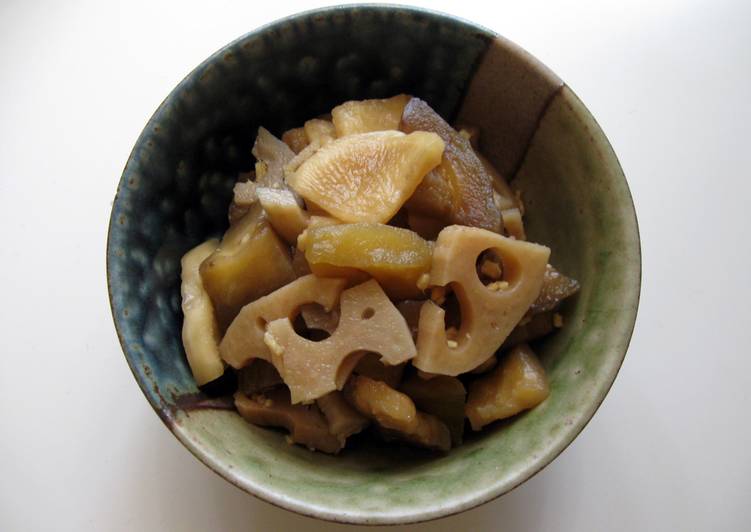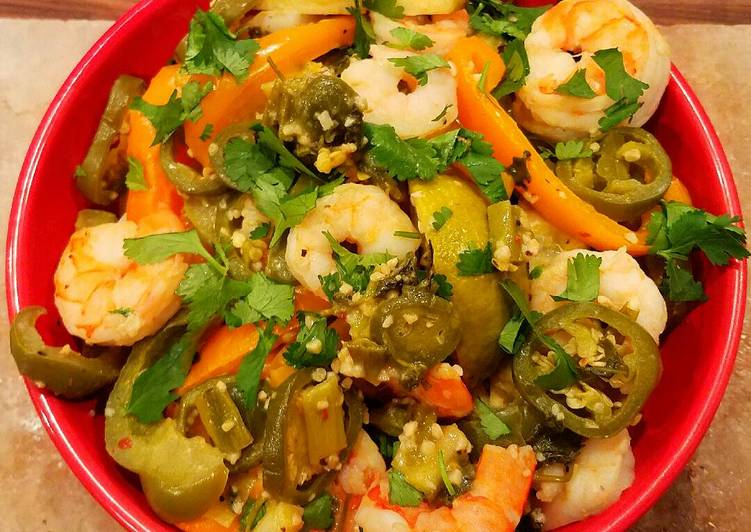
Hey everyone, hope you are having an amazing day today. Today, I’m gonna show you how to prepare a special dish, ‘fukujinduke’ pickles. It is one of my favorites food recipes. For mine, I’m gonna make it a little bit tasty. This is gonna smell and look delicious.
Fukujinzuke (福神漬) is a popular relish for Japanese curry. It includes daikon, eggplant, lotus root, cucumber and other vegetables that are finely chopped, then pickled in a soy sauce base liquid. Fukujinzuke is made of daikon and other vegetables that are marinated in sweet soy sauce with a touch of sourness.
‘Fukujinduke’ Pickles is one of the most favored of recent trending foods on earth. It is appreciated by millions daily. It is simple, it is fast, it tastes yummy. ‘Fukujinduke’ Pickles is something that I’ve loved my entire life. They’re fine and they look fantastic.
To get started with this particular recipe, we must prepare a few components. You can cook ‘fukujinduke’ pickles using 10 ingredients and 7 steps. Here is how you can achieve it.
The ingredients needed to make ‘Fukujinduke’ Pickles:
- Get 1 cup Daikon slices
- Make ready 1 cup Eggplant slices
- Make ready 1 cups Lotus Root (Renkon) slices *read ‘Method 4’ for how to prepare
- Get 1 teaspoons Salt
- Take 1 small piece Ginger *finely chopped
- Take 2-3 cm Kombu
- Make ready <Marinade>
- Prepare 2 tablespoons Soy Sauce
- Get 2 tablespoons Sugar
- Take 1/2 tablespoon Rice Vinegar
A wide variety of pickled fukujinzuke options are available to you Japanese pickles—known collectively as tsukemono—can easily go Fukujinzuke literally translates to "lucky god pickles," which is a reference to a Japanese myth about the seven gods of fortune. Fukujinzuke is a type of tsukemono, or Japanese-style pickle. The store bought variety is usually an assortment of daikon, eggplant, cucumber and lotus root, depending on the brand. "Fukujinzuke (福神漬) is one of the most popular kinds of pickles in Japanese cuisine, commonly used as a relish for Japanese curry. In fukujinzuke, vegetables including daikon, eggplant.
Steps to make ‘Fukujinduke’ Pickles:
- Keep skin of Daikon for crunchy texture, but Eggplant skin needs to be removed, otherwise you will have yucky coloured pickles!!! Cut lengthways into 2-3cm in diameter sticks, then cut them into 4-5mm thin slices.
- Place Daikon and Eggplant slices in a bowl, add Salt, mix well, then set aside for 1 hour OR overnight in the fridge if possible. Plenty of water should come out. Drain well and squeeze to remove excess salty water.
- Combine all the marinade ingredients in a small bowl. Heat in the microwave so that Sugar will dissolve well.
- Lotus Root needs to be blanched. Remove skin, clean, cut lengthways into 2-3cm in diameter sticks, then cut them into 4-5mm thin slices. Blanch in the boiling salted water with 1-2 teaspoons Rice Vinegar for 2-3 minutes, then drain well.
- Place all vegetables, finely chopped Ginger and Kombu in a right size jar or container. I have found a ziplock bag is the easiest option.
- Remove the air, so that the vegetable pieces can stay in this minimal amount of marinade. Marinate in fridge for 1-2 days before you enjoy. (*This time I doubled the amount.)
- *Mix with Macadamia Nuts: Crunchy ‘Fukujinzuke’ and crunchy Roasted Macadamia Nuts go well together.
Salt pickles, or shiozuke, are the simplest and most common types of pickles. Fukujinzuke is a mixture of Japanese radish (daikon), lotus root, cucumber and eggplant which are preserved in a soya. Vind stockafbeeldingen in HD voor Fukujinzukejapanese Pickles en miljoenen andere rechtenvrije stockfoto's, illustraties en vectoren in de Fukujinzuke/Japanese pickles. s. The Japanese name for these pickles means "lucky god pickles." This refers to a When making fukujinzuke, you can use whatever vegetables you like. For authentic katsu curries or quick and easy snacks.
So that is going to wrap it up for this special food ‘fukujinduke’ pickles recipe. Thanks so much for your time. I’m confident that you can make this at home. There’s gonna be more interesting food in home recipes coming up. Don’t forget to save this page in your browser, and share it to your loved ones, friends and colleague. Thank you for reading. Go on get cooking!


